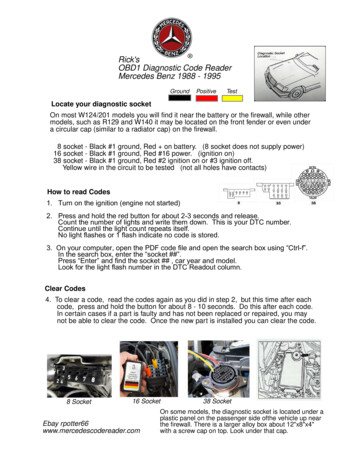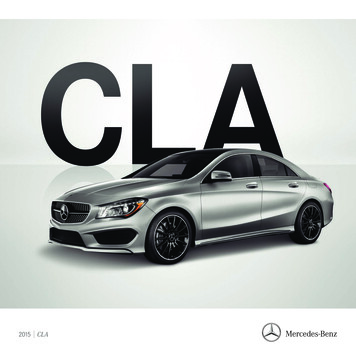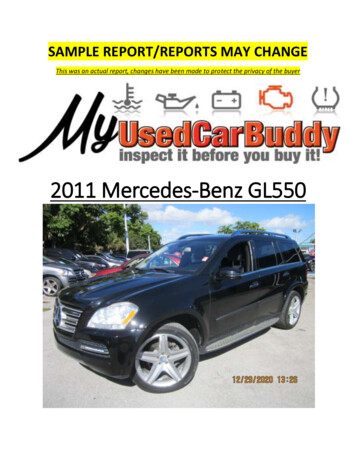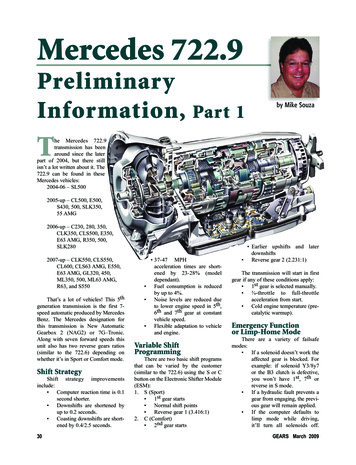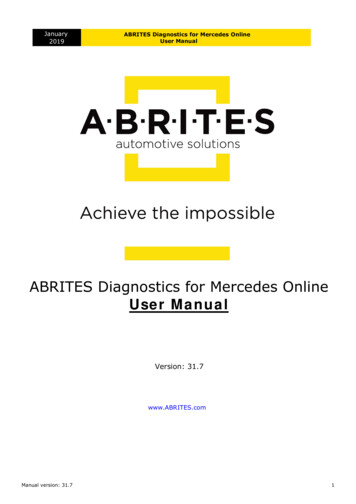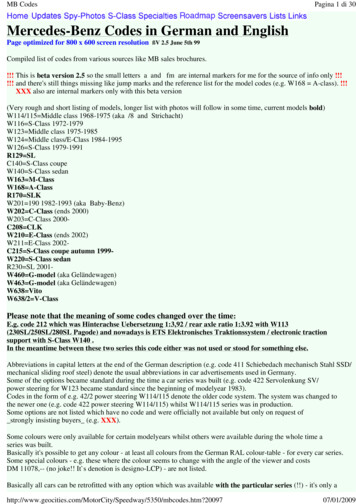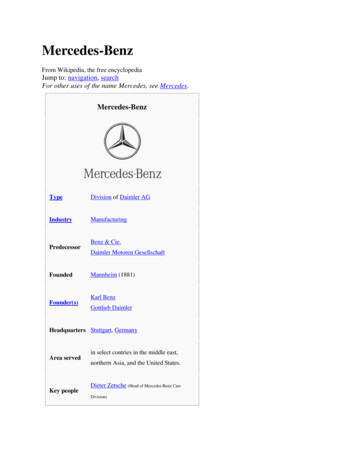
Transcription
Mercedes-BenzFrom Wikipedia, the free encyclopediaJump to: navigation, searchFor other uses of the name Mercedes, see Mercedes.Mercedes-BenzTypeDivision of Daimler )Benz & Cie.Daimler Motoren GesellschaftMannheim (1881)Karl BenzGottlieb DaimlerHeadquarters Stuttgart, GermanyArea servedKey peoplein select contries in the middle east,northern Asia, and the United States.Dieter Zetsche (Head of Mercedes-Benz CarsDivision)
AutomobilesProductsTrucksBusesInternal combustion enginesServicesFinancial servicesParentDaimler AGWebsitemercedes-benz.comMercedes-Benz (German pronunciation: [mɛʁˈtseːdəs ˈbɛnts]) is a German manufacturer ofautomobiles, buses, coaches, and trucks. Mercedes-Benz is a division of its parent company,Daimler AG. Mercedes-Benz traces its origins to Karl Benz's creation of the first petrol-poweredcar, the Benz Patent Motorwagen, patented in January 1886[1] and Gottlieb Daimler and engineerWilhelm Maybach's conversion of a stagecoach by the addition of a petrol engine later that year.The Mercedes automobile was first marketed in 1901 by Daimler Motoren Gesellschaft. The firstMercedes-Benz brand name vehicles were produced in 1926, following the merger of KarlBenz's and Gottlieb Daimler's companies into the Daimler-Benz company.[1] Mercedes-Benz hasintroduced many technological and safety innovations that later became common in othervehicles.[2] Mercedes-Benz is one of the most well-known and established automotive brands inthe world, and is also the world's oldest automotive brand still in existence today.[edit] HistoryMercedes-Benz S-class[edit] Business alliances[edit] Studebaker-Packard
In 1958, Mercedes-Benz entered into a distribution agreement with the Studebaker-PackardCorporation of South Bend, Indiana (USA), makers of Studebaker and Packard brandautomobiles.[3] Under the deal, Studebaker would allow Mercedes-Benz access to its dealernetwork in the U.S., handle shipments of vehicles to the dealers, and in return, receivecompensation for each car sold. Studebaker also was permitted to use the German automaker'sname in its advertisements, which stressed Studebaker's quality over quantity.[citation needed]When Studebaker entered into informal discussions with Franco-American automaker FacelVega about offering Facel Vega Excellence model in the United States, Mercedes-Benz objectedto the proposal. Studebaker, which needed Mercedes-Benz distribution payments to help stemheavy losses, dropped further action on the plan.[citation needed]Mercedes-Benz maintained an office within the Studebaker works in South Bend from 1958 to1963, when Studebaker's U.S. operations ceased. Many U.S Studebaker dealers converted toMercedes-Benz dealerships at that time. When Studebaker closed its Canadian operation and leftthe automobile business in 1966, remaining Studebaker dealers had the option to convert theirdealerships to Mercedes-Benz dealership agreements.[citation needed][edit] SubsidiariesMercedes-Benz AMG became a majority owned division of Mercedes-Benz in 1998.[4] Thecompany was integrated into DaimlerChrysler in 1999,[5] and became Mercedes-Benz AMGbeginning on 1 January 1999.[6][edit] Quality rankingsSince its inception, Mercedes-Benz had maintained a reputation for its quality and durability.Objective measures looking at passenger vehicles - such as J. D. Power surveys, demonstrated adownturn in reputation in this criteria in the late 1990s and early 2000s. By mid-2005, Mercedestemporarily returned to the industry average for initial quality, a measure of problems after thefirst 90 days of ownership, according to J.D. Power.[7] In J.D. Power's Initial Quality Study forthe first quarter of 2007, Mercedes showed dramatic improvement by climbing from 25th to 5thplace, surpassing quality leader Toyota, and earning several awards for its models.[8] For 2008,Mercedes-Benz's initial quality rating improved by yet another mark, now in fourth place.[9] Ontop of this accolade, it also received the Platinum Plant Quality Award for its Mercedes’Sindelfingen, Germany assembly plant.[9] As of 2009, Consumer Reports of the United States haschanged their reliability ratings for several Mercedes-Benz vehicles to "average", and arerecommending the E-Class and the S-Class.[10][edit] Corporate average fuel economyIn the United States, Mercedes-Benz was assessed a record US 30.66 million for their decisionto not meet the federal corporate average fuel economy standard in 2009.[11] Certain MercedesBenz cars including the S550, and all AMG models sold in the United States also face anadditional gas guzzler tax.[12]
In 2008, Mercedes had the worst CO2 average of all major European manufacturers, ranking 14thout of 14 manufacturers.[13] Mercedes was also the worst manufacturer in 2007 and 2006 in termsof average CO2 levels, with 181 g and 188 g of CO2 emitted per km, respectively.[14][edit] ProductionBesides its native Germany, Mercedes-Benz vehicles are also manufactured or assembled in: Argentina (buses, trucks and theSprinter van. The first MercedesBenz factory outside ofGermany)[15]Austria (G-Class)[16]Bosnia and HerzegovinaBrazil[17] Manufacture the trucks,buses, C-Class, GL-Class, CLSClass. Established in 1956. The AClass (W168) was produced from1999 to 2005 as well.CanadaEgypt via Egyptian GermanAutomotive CompanyHungary (construction of a newplant in the country announced on18 June 2008, for the nextgeneration A- and B-Class)[18][19]India[20]Indonesia[21]Iran (Not since 2010[22])Malaysia[23] [edit] Models[edit] Current model rangeMexico - Mercedes Benz de Mexico isMercedes's largest foreign branch byrevenue, number of sales, vehiclesmanufactured and total employees and coversmost of the Latin American and NorthAmerican market.Nigeria[24] (buses, trucks, utility motors andthe Sprinter van)PhilippinesSpain (Vitoria)South Africa[25]South Korea (Mercedes-Benz Musso andMB100 models manufactured by SsangYongMotor Company)Thailand (assembly of C, E and S classvehicles by the Thonburi Group)[26]Turkey[27]United Kingdom (The SLR sports car is builtat the McLaren Technology Centre inWoking).Brackley, Northamptonshire,United Kingdom Mercedes Grand PrixFactoryUnited States The Mercedes-Benz M-ClassSport Utility, the R-Class Sport Tourer, andthe full-sized GL-Class Luxury Sport UtilityVehicle are all built at the Mercedes-Benzproduction facility near Tuscaloosa,Alabama.[28]Vietnam Passenger cars and commercialvehicles. Established in 1995.[29]
Mercedes-Benz has a full range of passenger, light commercial and heavy commercialequipment. Production is on a global basis. The Smart marque of city cars has also been part ofthe Mercedes-Benz Group since 1994.[edit] Passenger carsSee also: List of Mercedes-Benz carsPope Benedict XVI in a Mercedes-Benz Popemobile in São Paulo, BrazilThe following passenger vehicles were in production in 2010: A-Class - subcompactB-Class - people carrierC-Class - sedan (saloon), sports coupé (CLC), and estateCL-Class - coupéCLK-Class - coupé, convertibleCLS-Class - 4 door coupéE-Class - sedan (saloon), coupé, convertible , and estateG-Class - 4WD cross-country vehicleGL-Class - SUVGLK-Class - SUVM-Class - SUVR-Class - crossover minivanS-Class - sedan (saloon)SL-Class - roadsterSLK-Class - roadsterSLR McLaren - hardtop grand tourerSLS AMG - luxury grand tourer[edit] TrucksSee also: List of Mercedes-Benz trucksMercedes-Benz is one of the world's largest manufacturers of trucks.[citation needed][edit] Buses and vans
Main article: Mercedes-Benz busesHitler's Mercedes Benz 770 Grosser Limousine in the Canadian War MuseumMercedes-Benz VarioMercedes-Benz also produces buses, mainly for Europe and Asia. Mercedes-Benz produces arange of vans. The first factory to be built outside Germany after WWII was in Argentina. Itoriginally built trucks, many of which were modified independently to buses, popularly namedColectivo. Today, it builds buses, trucks and the Sprinter van.[edit] Significant models produced 1928: SSK racing car1930: 770 "Großer Mercedes" state and ceremonial car1934: 500 K1936: 260 D World's first diesel production car1936: 1701938: W195 Speed Record-breaker1951: Mercedes-Benz 300, knownly as "Adenauer Mercedes"1953: "Ponton" models1954: 300SL "Gullwing"1959: "Fintail" models1960: 220SE Cabriolet1963: 600 "Grand Mercedes"1963: 230SL "Pagoda"1965: Mercedes-Benz S-Class1966: 300SEL 6.3
1968: W114 "new generation" compact cars1969: C111 experimental vehicle1972: Mercedes-Benz W107 350SL1974: 450SEL 6.91974: 240D1976: 300D1979: 500SEL and G-Class1983: 190E 2.3-161986: First 'E-Class'1991: 600SEL1993: First 'C-Class'1995: First 'Joint Mercedes-Benz & AMG' (C43 AMG)1995: Mercedes-Benz SL73 AMG, 7.3 V12 (biggest engine ever put in a Mercedes-Benz)1996: Mercedes-Benz Renntech E7.4RS1996: Mercedes-Benz CLK1997: Mercedes-Benz SLK1997: Mercedes-Benz M-Class2004: Mercedes-Benz SLR McLaren2004: Mercedes-Benz CLS2007: E320, GL320 Bluetec, ML320 Bluetec, R320 Bluetec2010: Mercedes-Benz SLS AMG[edit] McLaren carsA silver SLR McLaren on display at the 2006 European Motor Show in BrusselsMercedes-Benz has also produced a limited-production sports car with McLaren Cars, anextension of the collaboration by which Mercedes engines are used by the Team McLarenMercedes Formula One racing team, which is part owned by Mercedes. The 2003 MercedesBenz SLR McLaren has a carbon fibre body with a 5.4 litre V8 supercharged engine. This is thesame cylinder block as featured in SL55 AMG and the CLS55 AMG, though modified to give460 kilowatts (625 PS; 617 bhp) and 780 newton metres (575 ft·lbf) of torque. The SLR has amaximum speed of 337 kilometres per hour (209.4 mph) and costs approximately US 500,000.Due to European pedestrian-protection regulation, McLaren decided to cease production of theSLR in 2009.[30]
[edit] Car nomenclatureMercedes-Benz used the numerical representation of motor displacement with the letters placedthereafter to denote the type of motor, fuel delivery (in petrol motors), and body. The lastnumber is always zero. "E" denoted the fuel injection system (Einspritzung) in the petrol motorswhile "D" signified for diesel motors.Note: the letters described below are used prior to 1994 changes. "C" had been used for the two-door models on W114/W115, W123, and W124 as well asS-Class (W126 and W140) chassis. When combined with SL to create the SLC, the longwheelbase, four-seat closed coupé version of SL."K" was for the supercharged models in the 1920s and 1930s ("Kompressor") withexception of SSK, which meant "Kurz" (or short wheelbase)."L" meant "Leicht" (light): the first one to appear on SSKL in 1931. Beginning with theW108 in 1965, "L" means the long wheelbase version."R" is for the "Rennen" version as in 300SLR from 1955 (and SLR from 2003)."S" originally meant "Sport" as in SSK from 1928 and 300SL from 1953. However, the"S" designates the flagship four-door model, starting in the late 1950s. Eventually, "SE"and "SEL" were added to describe the fuel-injected model or long-wheelbase model.Initially for the US market, "SD" and "SDL" were the diesel version of S-Class (W116and W126)."T" was for the estate (or station wagon) using the word, "Touring", rather than Germanword, "Kombi". This appeared on S123 and S124.During the 1950s, some models carried the smaller letters: b, c, d as to differentiate between themodel trim level.In the 1960s, the numerical nomenclature sometimes didn't correctly reflect the motordisplacement in the S-Class but the position on the price range or specifications. Thus, 280SE 3.5in the late 1960s. 190 (W201 model built from 1982 to 1993) is unique to have same nameplateregardless of motor displacement or price range: 190E 2.3, 190D 2.2, and so forth. This wasnecessary to separate itself from W123 and W124, which didn't have its own class letter until1994.Beginning with the 1994 model cycle, Mercedes-Benz rearranged the alphanumericnomenclatures as to reflect the model classes better. The letters are placed before the motordisplacement and can be one to three letters, depending on model classes and types. No longer isit required to denote the fuel injection system as the carburettors have been "retired" due to theincreasingly strict emission control regulations.Some of the letters represent two or three different model types: "S" for both four-door saloonW140 and two-door coupé C140. This was further differentiated with new "CL" designationintroduced in 1997 for the C140. The E-Class saloon and coupé were not assigned the differentletters until the 1996 introduction of CLK-Class (C208 and A208).
The body types ("C", "L", and "T") are no longer assigned.If "K" is added to the class letters at the end, they denote the "smaller" version of the flagshipmodels: SLK, CLK, and GLK. CLS is the unique four-door coupé version that doesn't evenresemble the larger CL at all and even though it is based on E-Class chassis. CLC is the threedoor hatchback version of C-Class. Beginning with the W212 E-Class, the "CLK" designationhas been moved down to "C" level while "E-Class Coupé" is added as to better reflect itsposition in the price range between E-Class and S-Class."ML" rather than "M" was chosen due to the objection by BMW M-Motorsport as to avoid theconfusion between the BMW "M" models and Mercedes-Benz "M". However, Infiniti hasassigned "M" to its intermediate four-door saloon (M45) for the US market.SLR and SLS are only one without numbers.When the letters are placed after the numerical designation, they denote the type of fuel deliverysystem or forced induction. "K" is the "Kompressor" or supercharger."T" is the "Turbo", mostly found on smaller petrol A-Class and B-Class models (A200Tand B200T).The designation on the right-hand side is usually for the specific options such as "4Matic" and"AMG". "CDI" is affixed on the right-hand side unless "4Matic" option is
Mercedes-Benz From Wikipedia, the free encyclopedia Jump to: navigation, search For other uses of the name Mercedes, see Mercedes. Mercedes-Benz Type Division of Daimler AG Industry Manufacturing Predecessor Benz & Cie. Daimler Motoren Gesellschaft Founded Mannheim (1881) Founder(s) Karl Benz Gottlieb Daimler Headquarters Stuttgart, Germany Area served in select
